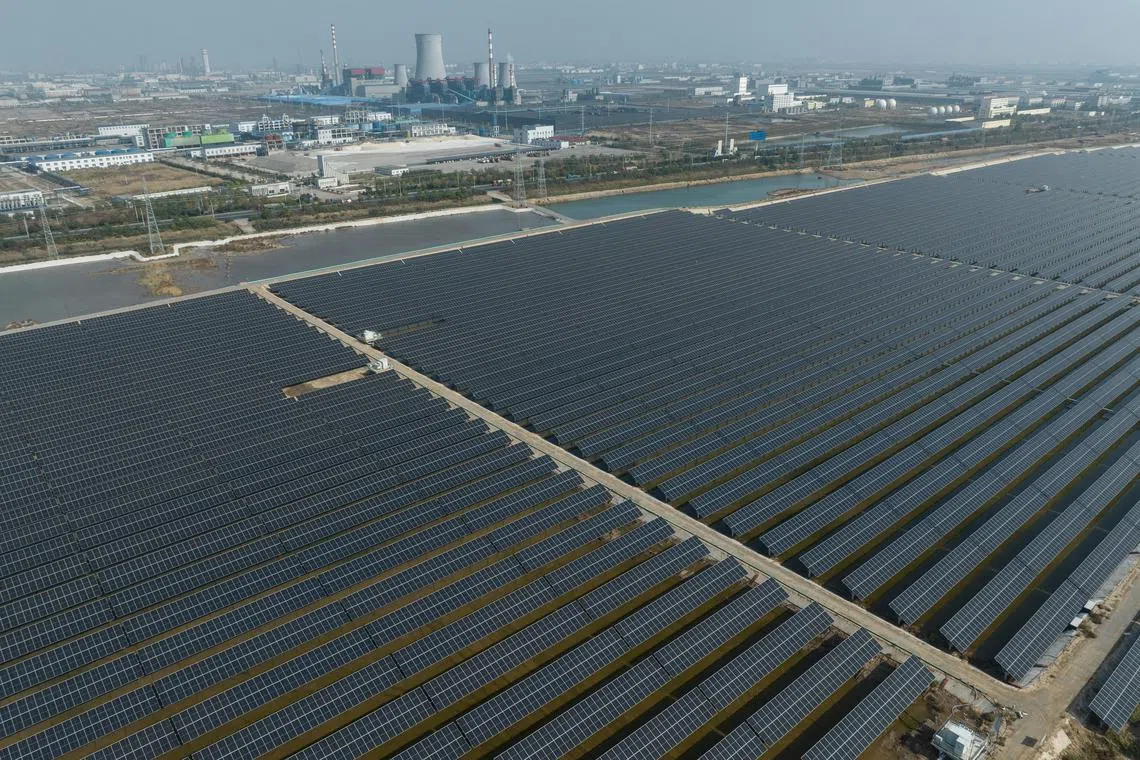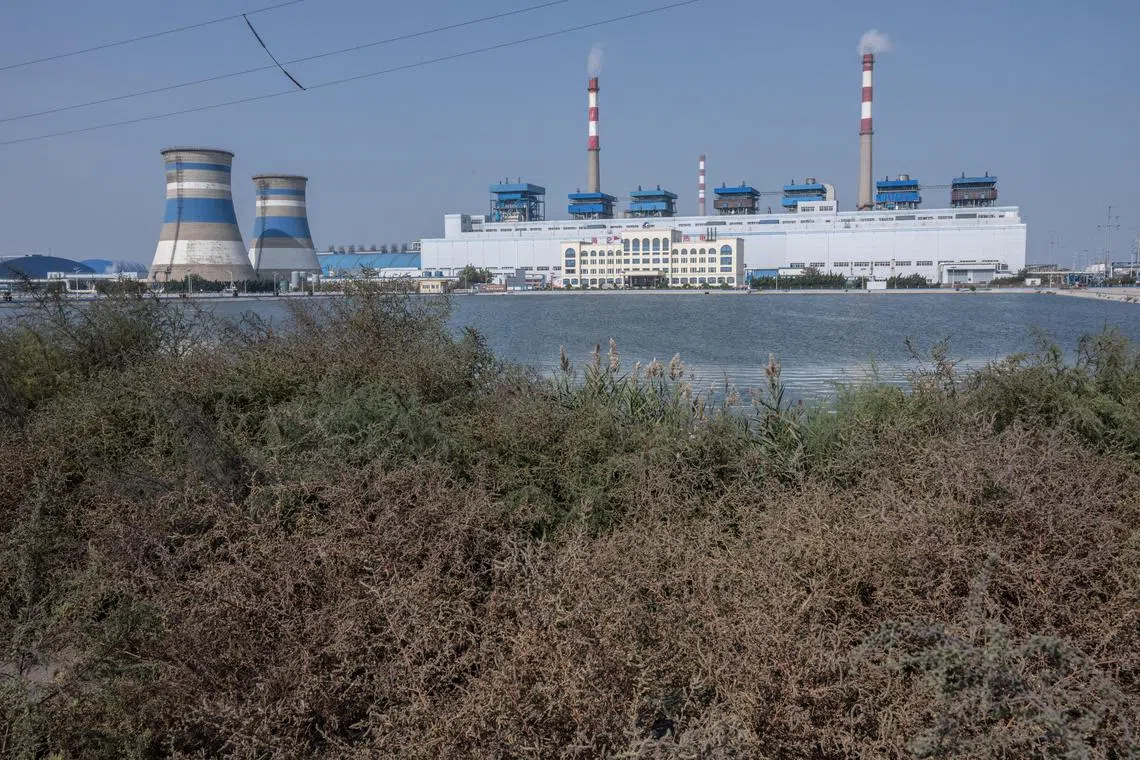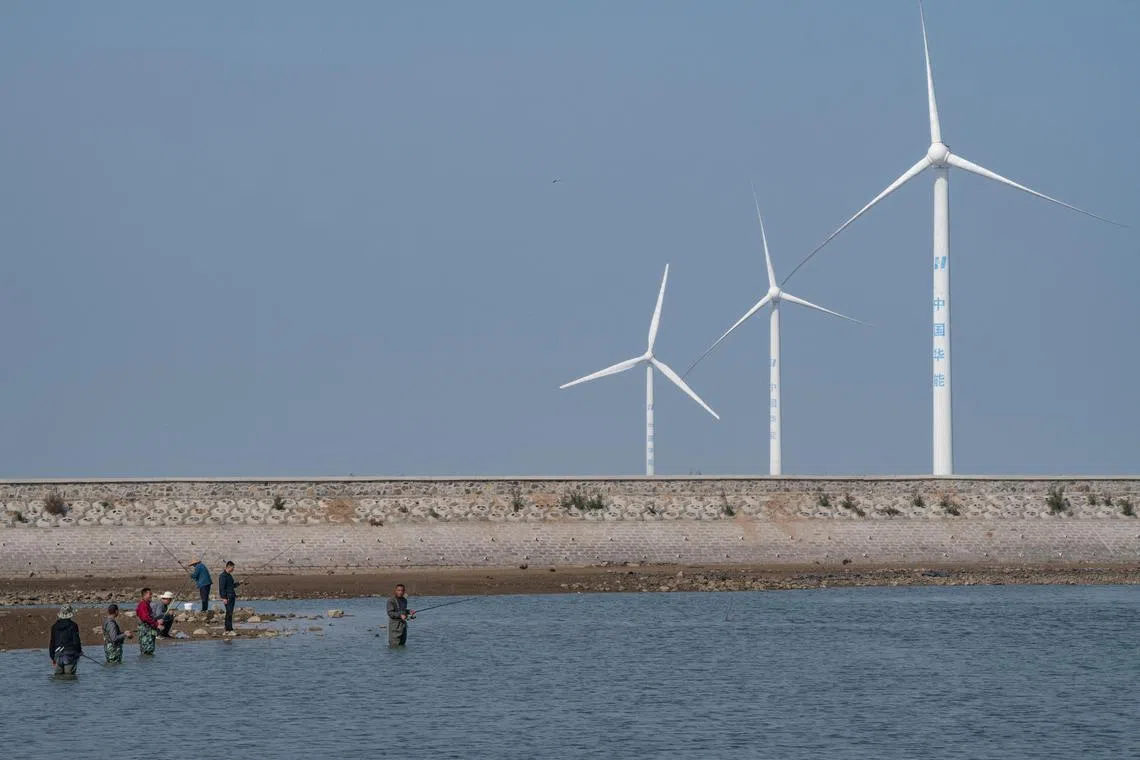China is winning in solar power, but its coal use is raising alarm
Sign up now: Get ST's newsletters delivered to your inbox

Cooling towers of a coal-fired power plant stand near an extensive solar panel farm in Weifang, China.
PHOTO: NYTIMES
Follow topic:
WEIFANG, CHINA – China is installing about as many solar panels and wind turbines as the rest of the world combined, and is on track to meet its target for clean energy six years early. It is using renewables to meet nearly all of the growth in its electricity needs.
Yet there is another side to that rapid expansion, one that is causing consternation in Washington at a critical period of climate diplomacy: China is also building new power plants that burn coal, the dirtiest of the fossil fuels, at a pace that dwarfs the rest of the world.
China accounts for one-third of the world’s energy-related greenhouse gas emissions
Mr John Kerry, US President Joe Biden’s special envoy for climate change, is hosting his Chinese counterpart, Mr Xie Zhenhua, for talks that started on Friday at the Sunnylands estate in Southern California, according to two people familiar with the matter who spoke on the condition of anonymity to discuss planning details. Former US president Barack Obama and China’s leader Xi Jinping began a joint push for climate action a decade ago at Sunnylands.
“Sunnylands is a symbolic place – it’s where the first US-China climate seeds were planted,” said Greenpeace East Asia policy adviser Li Shuo.
Two weeks later, climate will most likely be on the agenda when Mr Biden is expected to meet Mr Xi in San Francisco at the summit of Asia-Pacific Economic Cooperation countries. Then world leaders will gather in Dubai at the start of December for COP28, the latest round of global climate negotiations.
It is not an exaggeration to say the health of the planet depends on the actions of the United States and China. The US has pumped the most carbon dioxide into the atmosphere over the past two centuries, and China is the current largest polluter. Their willingness to slash emissions will essentially determine whether the planet continues to dangerously heat up, leading to the disappearance of coral reefs, ice-free Arctic summers and widespread displacement from intensified storms, floods and wildfires.
But more than ever, decisions made in Beijing could outweigh those made in Washington or European capitals.
“China’s annual emissions are so massive that cutting them is now the key to any hope of preventing global temperature spikes and climate disasters,” said Mr Paul Bledsoe, a former Clinton administration climate official.
In Shandong province, a peninsular hub of heavy industry between Beijing and Shanghai, China’s energy decisions are plainly visible. Solar panels interspersed with immense wind turbines stretch into the distance on the province’s north coast. More wind turbines and solar panels festoon hillsides and cornfields in the interior. On rooftops and sometimes the south-facing walls of apartment towers, solar panel installations soak up the sun’s energy.
Solar power producers in Shandong generate so much electricity at midday, exceeding demand, that they sometimes have to pay the provincial transmission grid to accept it. They do so to continue collecting government subsidies based on how many kilowatt-hours they produce.
In some ways, China has come further in addressing climate change than almost anyone expected several years ago. Mr Xi announced in December 2020 that China planned to triple its wind and solar capacity by 2030. China is on track to reach that target by the end of next year, said Mr Frank Haugwitz, a solar industry consultant who specializes in China’s data.
Chinese officials could announce greater renewable energy ambitions as they approach the existing target.
US officials, however, are more concerned with China’s coal development, and are unlikely to praise new clean energy pledges that are not paired with aggressive measures to curb carbon dioxide emissions.
Because of China’s size, its solar and wind power may not be enough to address climate change if it doesn’t turn away from coal, climate experts say.
“You’d be insane if you’re trying to advance this cause globally not to be focused on coal,” Mr Kerry said in Beijing this summer.
He has said the US and China agreed that countries should be reducing coal at a faster rate, but not on how fast it should be done.

China contends that its coal plants are designed to minimize overall emissions and make it possible for China to use more renewable energy.
PHOTO: NYTIMES
Chinese officials have defended the coal-fired plants as needed for national energy security. The country imports most of its oil and natural gas but has the largest coal reserves.
China contends that its coal plants are designed to minimize overall emissions and make it possible for China to use more renewable energy. The government requires that new coal-fired plants no longer be built to run only at essentially full capacity. They must also have the capacity to ramp their electricity generation up and down to offset surges and dips in renewable energy. China has also retrofitted almost all older power plants to allow similar flexibility, said Mr Zhang Jianyu, the executive director of the BRI International Green Development Institute, an environmental group in Beijing.
China has also invested heavily over the past few years in transmission to connect more parts of the country to its solar farms and wind turbines. In August, the most recent month data is available, 97.8 per cent of the electricity generated by wind and 98.8 per cent of the solar energy was used – indications that China is deploying its renewable energy effectively.
Mr Nate Hultman, director of the Centre for Global Sustainability at the University of Maryland, said it was critical for China to work on grid reliability – an issue that could determine whether China uses all the coal it has developed.
“If they know how to run their grids with high levels of renewables and improved efficiency, that will relieve some pressures on needing to use coal,” said Mr Hultman, a former aide to Mr Kerry. “The real outcome for climate depends on how you manage that grid.”
On the western outskirts of Weifang, a town in northern Shandong, the Minghui Photovoltaic Power Generation Company and other nearby solar providers were ordered to halt new installations for at least three months while the grid catches up, said a manager at the company who agreed to speak only if identified by his surname Wu.
Geography and weather patterns pose challenges for China in reducing coal use. Most of the country’s large, energy-thirsty cities are in areas where wind is minimal. That makes solar generation and efficient transmission from other regions crucial.
By contrast, the coastline is windy.

China has also invested heavily over the past few years in transmission to connect more parts of the country to its solar farms and wind turbines.
PHOTO: NYTIMES
In Weifang, which hosts international kite-flying contests, hundreds of wind turbines stand in tidal pools along the city’s 113km seashore. Building turbines miles out to sea, as Europe has done, has been hard for China because much of the sea floor is soft and muddy.
One reason for China’s rapid deployment of renewable energy is favourable zoning laws and public support. Approvals for renewable energy are quickly issued, in contrast with often lengthy procedures in the US, where one county scheduled 19 nights of meetings to debate a single wind farm.
Sharp improvements in air quality in China have also helped build public support for renewable energy – although scientists say more stringent pollution limits on factories, boilers and vehicles have played a central role in scrubbing the country’s air. From 2013 to 2021, China reduced fine particle pollutants by 42 per cent, according to a University of Chicago analysis of satellite photos.
Ms Zhu Peng, a fertiliser salesperson who went fishing on a recent morning on a Weifang beach, said she welcomed the wind turbines looming nearby.
“For us, this is the scenery,” she said. “I don’t think it’s disturbing at all. Otherwise, we can see nothing but water and rocks.” NYTIMES.

